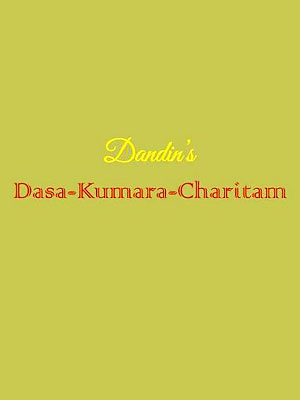 Dashakumaracharita is considered as an attempt by Dandin to teach the doctrines of the Nitishastra through attractive characterization. He basically aimed at giving pleasure. One of Dandin`s major qualities is treating a simple tale in a grand manner as that of a Kavya. This has made the tale vitally different from its effect in a simple form. Dandin`s treatment has made the narrative a mere skeleton and the description is the essence. Dashakumaracharita describes the adventures of ten princes, who have been divested: Somadatta, Puspodbhava, Rajavahana, Apaharavarman, Upaharavarman, Arthapala, Pramati, Mitragupta, Mantragupta and Visruta and their chases of love and power.
Dashakumaracharita is considered as an attempt by Dandin to teach the doctrines of the Nitishastra through attractive characterization. He basically aimed at giving pleasure. One of Dandin`s major qualities is treating a simple tale in a grand manner as that of a Kavya. This has made the tale vitally different from its effect in a simple form. Dandin`s treatment has made the narrative a mere skeleton and the description is the essence. Dashakumaracharita describes the adventures of ten princes, who have been divested: Somadatta, Puspodbhava, Rajavahana, Apaharavarman, Upaharavarman, Arthapala, Pramati, Mitragupta, Mantragupta and Visruta and their chases of love and power.
The main significance of the romance lies in the substance, its vivid and picturesque account of low life and adventure, of magicians and fraudulent holy men, of princesses and ruined kings, of expert thieves and of fervent lovers. Apaharavarman is a prince of thieves who plans on the model laid down by Karmsuta, to rob a city in order. He is also aware that there are many misers in residence. Mantragupta in disguise himself as a foolish king, who persuades him to bathe in the sea in order to obtain greater beauty, kills him. He exhibits himself as the new form of the king. Visruta to secure his protege`s reinstatement to power makes use of the temple and the name of Durga to pull off a successful fraud. The gods appear justifying the shocking deeds. Here the moon god is cited as justifying infidelity. The hetaira is successful in her effort to distort the pious ascetic.
The ascetic is far from being adamant, and it is not Brahmins alone who are subject to satire ; the merchant whom she plunders down to his loin-cloth abandons that also and becomes a Digambara Jain monk, but confesses that the sublime teachings ofthe Jina are but a swindle. The Brahmins again with their reports of evil, requiring a special sacrifice with vessels of pure gold, are derided, while nuns are all go-betweens and one Buddhist lady is the head procuress in the service of a hetaira. The might of fate does not rule the affairs of these active princes; true, Apaharavarman when caught stealing, Purnabhadra captured by robbers, ascribe to this cause their mishaps, but they both are ready and able by human exertion to defeat effectively the decrees of that unstable deity.
His outlook is in accord with one strain of Indian tradition, that which from the Rig Veda onwards describes the sins of the gods without moral protest. The king`s domestic priest also possesses the holiness of Brahman himself. Despite his good deeds Brahmin Matanga is restored to life. As he was devoted to Lord Shiva he is rewarded with the help of Rajavahana to enable him to win an Asura princess and lordship of Pataal. Shiva`s club gives victory to the king of Malwa over Rajahansa.
Dandin`s characterisation is powerful. He is not content in making alive the major figures on stage, however invests with life and reality the minor characters. The ascetic Marishi, the merchant Vasupalita, and their seducer Kamamanjan, the old Brahmin who meets Pramati at the cockfight, the police commandant Kantaka, who is deceived into believing that the king`s daughter is in love with him and treasures the nurse`s soiled garment as a pledge of affection, and the nurse herself who instants Apahara-varman`s efforts to win the princess are depicted with energy, force and insight.
The humour and wit of the author are amazing and attractive to modern taste. The whole work has prevalent humour of the wild conduct of the princes, their determination to secure what they wish and their light-hearted indifference to the morality of the deed which they employ. The deception of Marishi by the hetaira is very well drawn.
Arrangement of his work Dandin shows distinct judgement. He varies his tone from the light-hearted or grim humour of to earnest tragedy. He alters his form as in chapter vi there are four clever tales, those of Dhumini, Gomini, Nimbavati, and Nitambavati.
Purvapithika is an introductory text that comprises of five ucchvasans. The Uttarapithika consists of eight ucchvasans deal with the adventures of eight princes: Rajavahana, Apahaaravarma, Upaharavarma, Arthapala, Pramati, Mitragupta, Mantragupta and Visruta.













